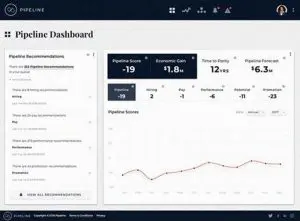Here’s what we know: Equality in the workplace (that includes equal pay and equal representation at all levels of organizations) could add between $2.1 trillion and $4.3 trillion to the U.S.’s GDP in the next decade. But estimates from the U.S. Congress Joint Economic Committee suggest that it’s going to take over 40 years to get there.
Katica Roy wants to change that, or at least accelerate the process, through AI. That’s why she left the corporate world (as a global VP at SAP) and cofounded Pipeline, a software company that uses AI to help businesses boost their bottom line by operationalizing gender equity.

To Roy, it just makes good business sense to have equity. Before Pipeline launched, she says they did a research study of 4,000 companies in 29 countries. “We found that for every 10% in gender equity toward parity, there was a 1%-2% increase in revenue,” she says. Without full representation, Roy notes, companies were constricting their economic footprint.
Roy says they also did a lot of research around the headwinds women face as they progress (or not) in their careers. “Men are promoted at a rate of 30% greater than women,” says Roy when they are moving from individual contributor to management. What they observed is that the number of women gets successively lower the higher up the corporate chain you get. “The glass ceiling,” she observes, “starts pretty far down.” Pipeline’s whole premise then was to look at a company’s workforce data and course correct before decisions like promotions are made, she says.

For example, she says, Pipeline’s AI gets to work when a company is posting a job by recommending a slate of internal candidates who could fill the position. To do this, each recommended employee is scored by their skills as well as for the gender makeup of the team they are joining. Performance reviews go through the AI’s natural language processing to ensure the review isn’t gender-biased.
Pipeline is getting the most traction in the financial services, tech, and restaurant industries. Many of the companies using Pipeline have made a public commitment to equity, like Paradigm for Parity. “What those companies find is that it is harder to live the pledge than to make it,” says Roy. And it’s tough to justify a lot of money spent when the numbers are barely moving or going backward, especially in a tight labor market.
That’s why Pipeline also gives participating companies a score ranging from -100 to +100 that shows how each decision they make impacts their overall score. That analysis also provides a forecast of the investment they need to make if they are going to hire or promote someone to achieve greater parity, and when they would see returns. “It’s not magic,” Roy admits. “It doesn’t happen overnight.” She says that on average it takes about three years to see a return by virtue of the adoption rate of the recommendations.
While Roy didn’t divulge exact figures, she did say that the companies currently using the platform have accepted about 30% of the platform’s recommendations. “That’s higher than what we see from general adoption from software space,” she adds. The transparency of the analysis does at least allow companies to see where the gaps are, and hopefully fix them starting from the rank and file, so that women’s earnings don’t lag behind their male counterparts. Roy insists that while equal pay for equal work is important, “the bigger issue is equal opportunity [for women to advance]. Pipeline’s detailed analysis is one way to make sure to bridge that gap, she says. “It’s a scalpel rather than an axe.”
Recognize your brand’s excellence by applying to this year’s Brands That Matter Awards before the early-rate deadline, May 3.
